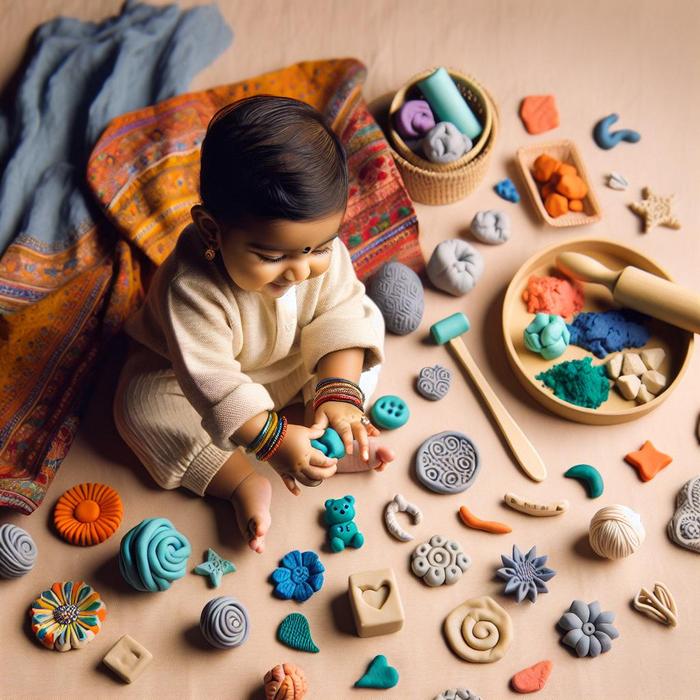Learning Through Creative Arts and Play Dough Activities
Play dough is not just a fun and engaging material for children; it’s also a fantastic learning tool. The versatility of play dough provides endless opportunities for creative arts and play dough activities that can assist with sensory experiences and enhancing a child’s fine motor skills development.
When we first introduced play dough to our baby, we noticed an immediate spark of curiosity. This simple, versatile material seemed to open a whole new world of exploration for our little one. It was a delight to see the ways our baby manipulated the dough – squishing it, rolling it, and even tasting it! We learned that these were not just fun games but sensory play ideas that could offer significant benefits to our baby’s growth and development.
Boosting Fine Motor Skills Development with Play Dough
As our baby continued playing with the play dough, we started to discover it was more than just a plaything. It was an incredible tool for fine motor skills development. The actions involved in squishing, kneading, and molding play dough are great exercises for developing muscles in the hands and fingers. These muscles are vital for skills like writing, tying shoelaces, or using a spoon.
- Rolling the dough into balls or ‘snakes’ helps strengthen these muscles.
- Using cookie cutters or play dough tools is a fantastic way to practice hand-eye coordination.
- Creating shapes and figures with the dough encourages precision and focus.
Additionally, we realized that mixing different colors and creating various shapes with the dough also introduces concepts of color, shape, and size, essential early maths and science knowledge.
Stimulating Sensory Play Ideas with Play Dough
Play dough is also a fantastic medium for sensory play ideas. Its unique texture provides an excellent opportunity for our baby to engage with different sensory experiences.
- The soft texture of the dough is pleasing to touch, and it can be made even more interesting by adding elements like sand or rice for a different sensation.
- The various shapes and figures that can be created out of play dough engage sight.
- Adding a few drops of essential oils or food flavorings can even engage smell, creating a multi-sensory play experience.
These sensory experiences can help our baby understand and interpret the world around them better. Plus, the concentration needed to mold and shape the dough can also lead to improved focus and patience.
Integrating Play Dough into Everyday Activities
Given the benefits of play dough, we’ve integrated it into our child’s routine. We create play dough activities that not only help enhance sensory and motor skills but also promote language development. For instance, we use play dough to tell stories, encouraging language skills and imaginative play.
Through play dough, our baby learns, explores, and grows, proving that sometimes, the simplest toys can offer the most significant benefits.
Creating Different Types of Play Dough for Different Sensations
The types of play dough you can make are as varied as the activities you can use them for. One of our favorite types of play dough to create is sand play dough. Combining the squishy sensation of play dough with the gritty texture of sand offers a unique sensory experience and an exciting change of pace from traditional play dough.
Creating sand play dough activities can provide additional insight into diverse sensory textures and intensify the creativity involved in play dough engagement. The process of making the dough also provides an excellent opportunity for your baby to be involved in a hands-on activity.
Creative Play Dough Activities to Consider
There is no shortage of creative arts and play dough activities to keep your child’s imagination flowing. Here are a few different activities we’ve found to be especially beneficial:
- Creating imprints in the dough with various objects like shells, leaves, or textured fabrics to encourage exploration of patterns and shapes.
- Using play dough to create famous landmarks or scenes from their favorite stories stimulates their historical and literary connections.
- Inviting your baby to craft different animals or objects, enhancing their three-dimensional thinking and creativity.
These activities help keep play dough time fresh, exciting, and educational, making sure our baby never gets bored while exploring new learning avenues using play dough.
Bringing Education and Play Dough Together
With the plethora of beneficial play dough activities available, it’s easy to incorporate an educational element into your child’s play time. With simple play dough activities, like creating numbers or alphabets, children can engage their minds and enhance their cognitive skills while having fun.
Alternatively, you can also introduce your child to fine motor activities with play dough to give them a stronger foundation in their academic journey. These activities allow your child to develop their fine motor skills, which are crucial in playing musical instruments, using scissors, and even writing!
The Impact of Play Dough on Emotional and Social Skill Development
We’ve noticed that play dough creates opportunities for our baby to enhance their emotional and social skills too. Through the act of sharing and taking turns while playing with play dough, our baby learns about cooperation, respect for others, and empathy.
Plus, smashing, squeezing, and squishing play dough offers an excellent outlet for dealing with frustration and anxiety, improving their emotional health. These are just a few more reasons why we believe play dough is such a valuable tool for promoting holistic growth in our child’s development.
The Untapped Potential of Play Dough
From everything we’ve experienced, it’s clear to us that play dough holds an enormous amount of untapped potential that goes beyond simple play. Whether it’s language development, sensory experiences, fine motor skills, or socio-emotional skills, the benefits of play dough activities are far-reaching.
Despite its simplicity, play dough is a multipurpose tool that promotes an array of developmental skills in a fun and interactive way. We encourage all parents to explore and utilize this versatile play material with their children, to witness firsthand its positive impact on your child’s growth and learning.






